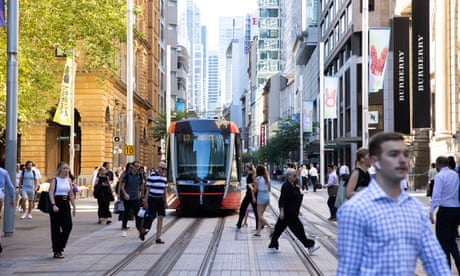- by foxnews
- 06 Mar 2025
Snail rail: why are trams in Australian cities running slower than they were 100 years ago?
Snail rail: why are trams in Australian cities running slower than they were 100 years ago?
- by theguardian
- 22 Jan 2023
- in news

Trams on a recently revived light rail route in Sydney and on one Melbourne line are so slow they would be outpaced by trams that ran almost 100 years ago, new analysis reveals.
Average speeds do, however, increase on other routes, with services on the Central to Dulwich Hill line averaging 20km/h. Trams travelling from Central to Randwick and Juniors Kingsford average 21km/h, which is higher than when the lines opened in late 2019 and April 2020, and there were restrictions in place to help road users get used to the new trams.
But the modern-day system lags behind historical speeds in some areas.
Clifton said tram routes that run through the city centres of Sydney and Melbourne consistently run slower than suburban routes due to more frequent stops, longer dwell times because of higher passenger numbers and as a consequence of more interference from traffic.
Clifton said public transport operators commonly manipulate timetables to allow for over generous trip times, which makes it easier for performance targets to be achieved.
Acceleration can play an even bigger role in slowing down trams on routes which do not have their own exclusive lanes or separate corridors. He says this is why trams on the Gold Coast and in Canberra run faster than in Melbourne and Sydney.
Despite this, Melbourne trams frequently average decent speeds because they can glide through intersections. This is due to trams long having had priority at traffic signals, a Victorian transport department spokesperson said.
Tramcars are fitted with transponders that are picked up by detectors placed in the lead up to intersection, so when a tram is approaching, a green light will appear at the intersection earlier to maximise the chance of the tram getting through without stopping.
On some roads, trams are also able to activate a right turn phase to clear right turning vehicles queued in the path of the tram.
Authorities in Melbourne are even planning to bolster tram priority by sending real time GPS data from trams to crosscheck it against the timetable to create more favourable traffic lights and clear intersections ahead if the tram is running late.
Transport for NSW notes that the trip time from Kingsford to the city has dramatically increased since the line was launched.
Clifton says Australian attitudes towards safety, which often err on the side of caution, also contribute to slower tram speeds.
He says trams overseas accelerate fast out of stops, but that there is less cultural acceptance of this for riders and from other road users in Australia.
Clifton added that tram driving styles have also changed in Australia in recent decades.
- by travelandtourworld
- descember 09, 2016
Albania Bans TikTok for One Year Over Youth Safety Concerns Amid Growing Social Media Scrutiny
Albania has officially announced a year-long ban on TikTok, becoming the latest country to take action against the social media platform amid concerns over youth safety and digital security. The decision, revealed by Education Minister Ogerta Manastirliu, comes as part of broader efforts to regulate online content and minimize the platform’s perceived negative influence on young users.
read more


